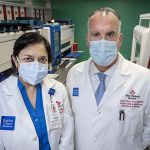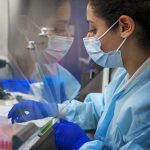From our first COVID test in March 2020, Texas Children’s reached the remarkable milestone of administering, analyzing and reporting 500,000 COVID tests on Feb 9, 2022. This is a significant number for a pediatric hospital, according to Chief of Laboratory Medicine and Chief of Pathology Informatics, Dr. Ila Singh. As of March 16, 531,735 patients have been tested, with 50,362 patients testing positive.
In December 2019, well before what was then called the Wuhan Coronavirus was detected in the U.S., Dr. Singh, together with Dr. James Dunn, Medical Director of the Clinical Microbiology Laboratories and Pathologist-in-Chief Dr. James Versalovic began to develop a viral diagnostic test. Texas Children’s was one of the first hospitals in the Medical Center to offer COVID-19 testing starting in March of 2020. Sarah Montenegro, Transition Care Program Assistant Vice President and members of the COVID-19 Testing Taskforce were able to coordinate and begin operating eight testing sites to serve Texas Children’s employees, as well as patient testing centers on units.
Navigating this new set of circumstances alongside the rest of the world brought new challenges and a new level of cooperation. Staff with expertise in Oncology testing offered their services for COVID testing, which needs a similar skill set. Along with realigning and adding lab, nursing and other staff in multiple areas to handle additional responsibilities came unforeseen challenges to troubleshoot and resolve, such as supply chain shortages and disruptions. “We had to use all the tools in our toolbox to make sure we could meet testing needs and provide accurate results in a timely manner,” said Dr. Dunn.
Numerous considerations were taken into account for planning how, where and when to offer testing; how to record, analyze, report and act on results; guidelines for visitors; and protocols for quarantining and returning to work following a positive test.
“We developed new protocols that we continue to use to help make environments safe for patients and employees,” said Dr. Singh. “Testing our patients and practicing vigilant safety protocols allowed us to keep our hospitals and clinics open and continue to provide medical procedures.”
Since that time, testing technology has evolved, allowing Texas Children’s to offer rapid tests that provide results in less than two hours, and tests that can diagnose COVID-19, as well as Influenza and other respiratory infections. Tests that look for SARS-CoV-2 antibodies were developed to help in the diagnosis of Multisystem inflammatory syndrome in Children (MIS-C) and to determine if someone developed immunity following vaccination.
“It takes a village to execute our COVID operations,” said Dr. Singh. As she explained, many people are involved in testing, from those stationed at drive-through sites, who collect specimens, to the lab personnel who analyze specimens and report results, to pathologists who provide test interpretation, to informaticists who use testing and patient data to create reports that are used by hospital executives for making informed decisions about hospital operations. These reports are shared with local, state and federal organizations to help generate the COVID data maps that we have gotten used to seeing in newspapers.





